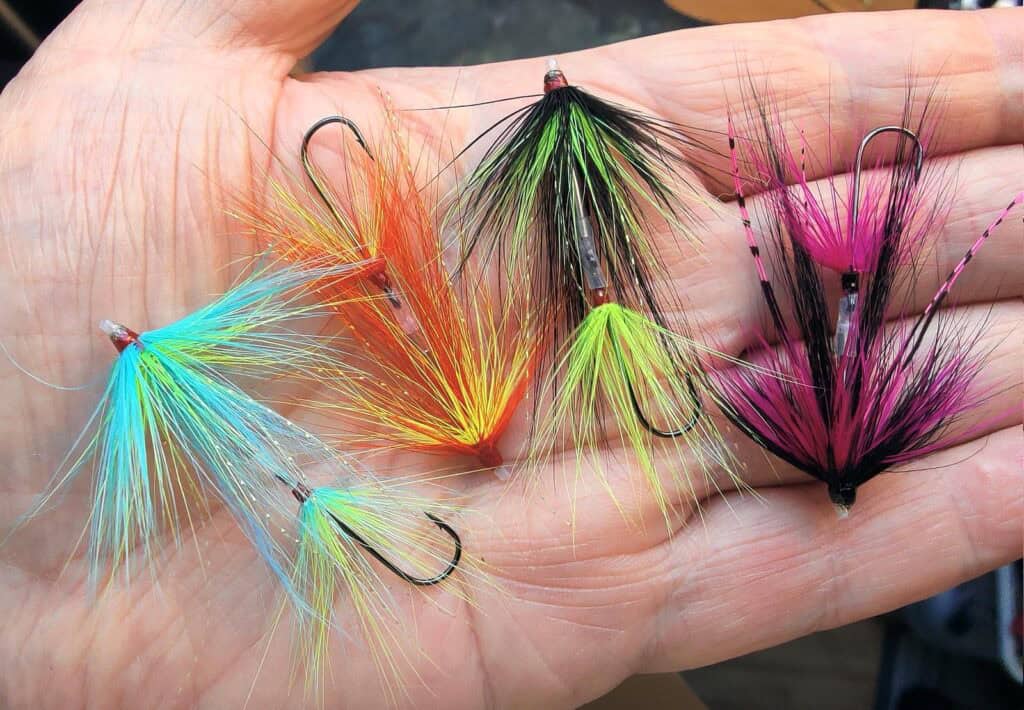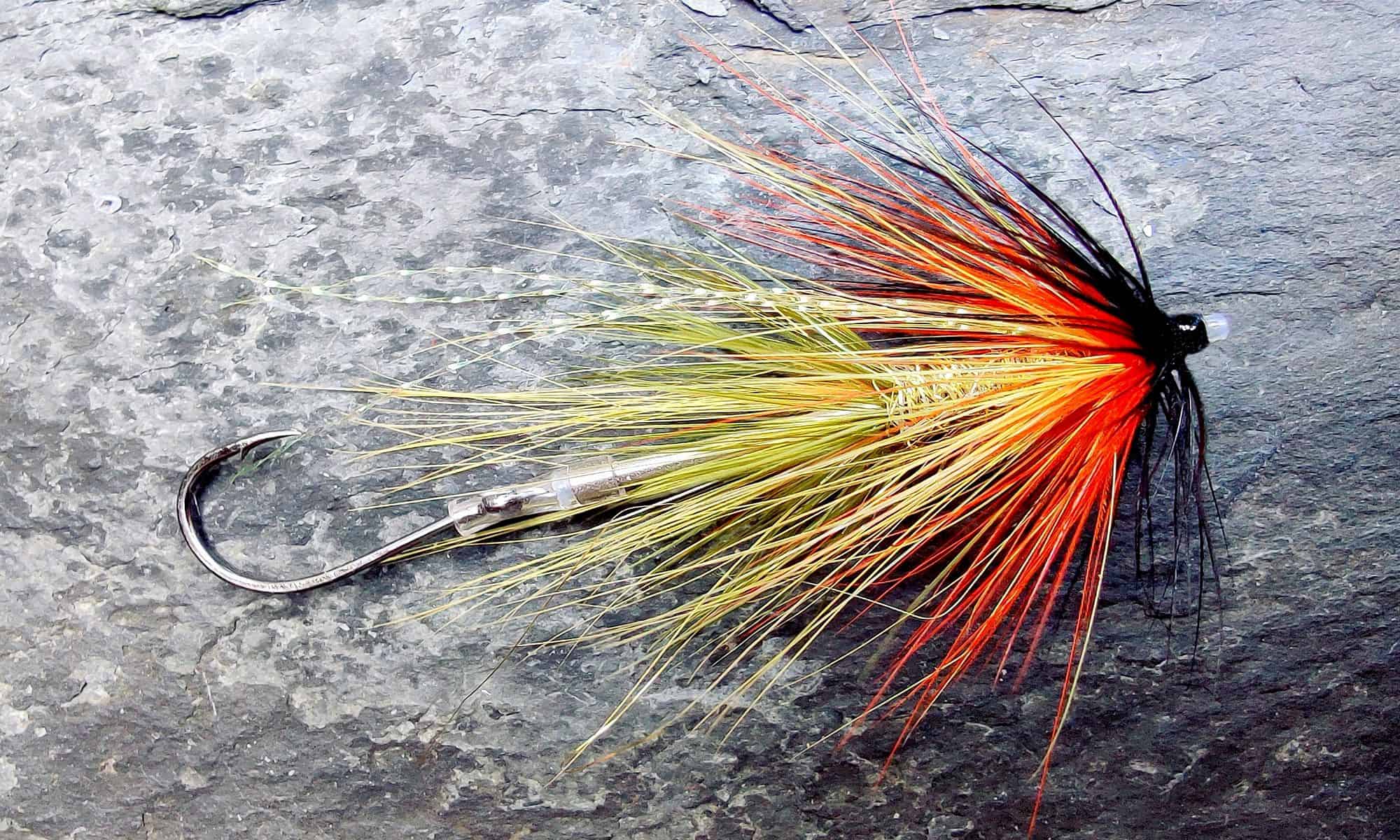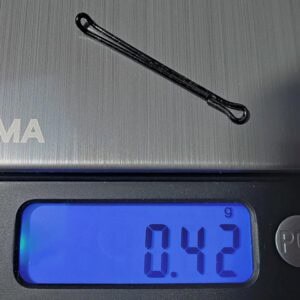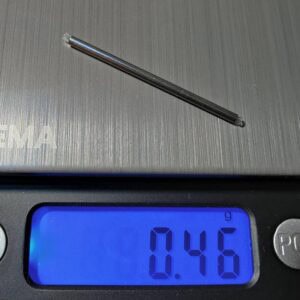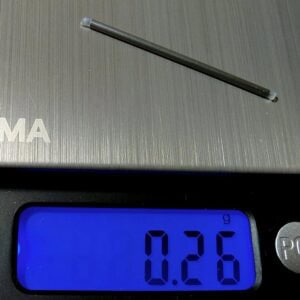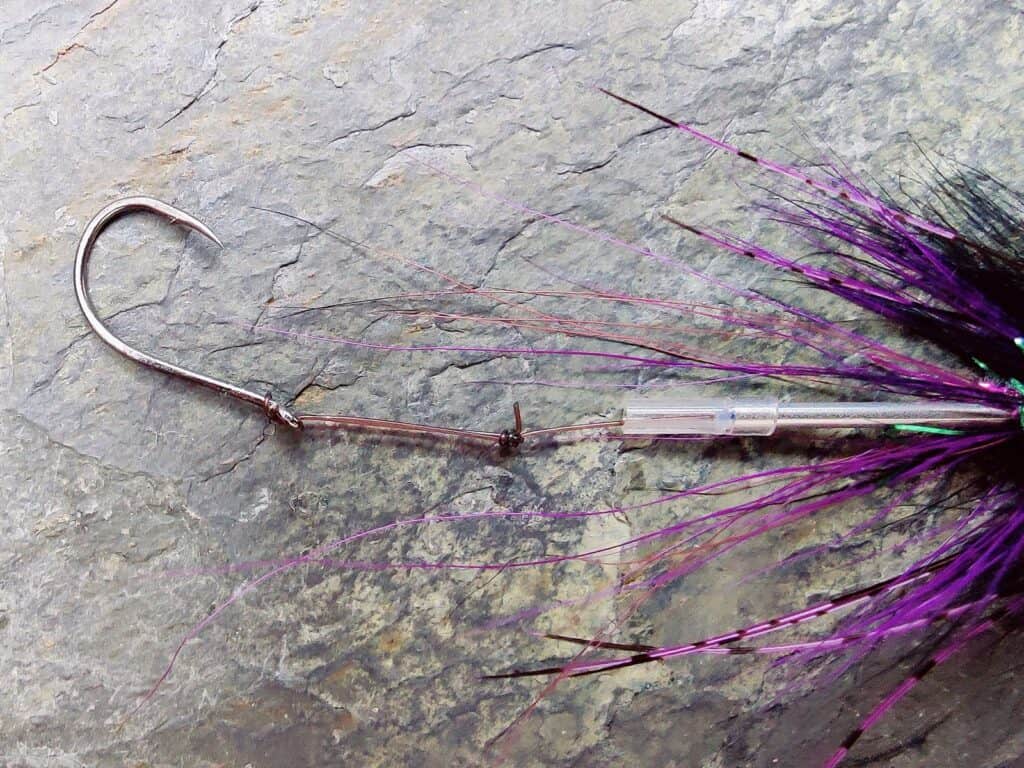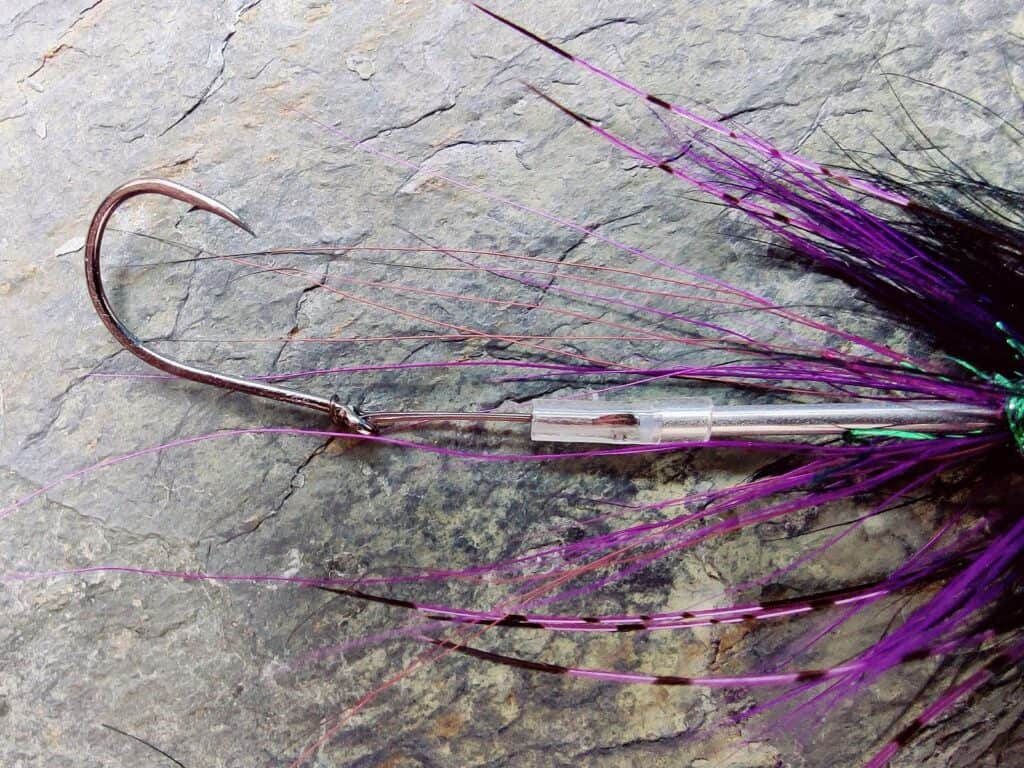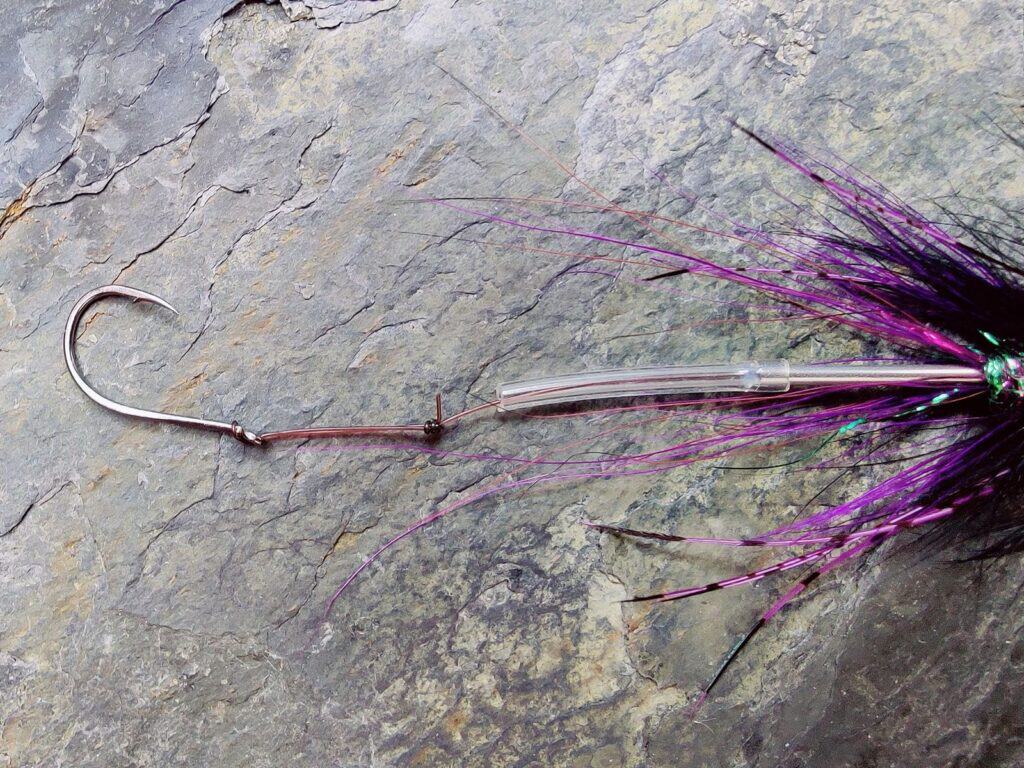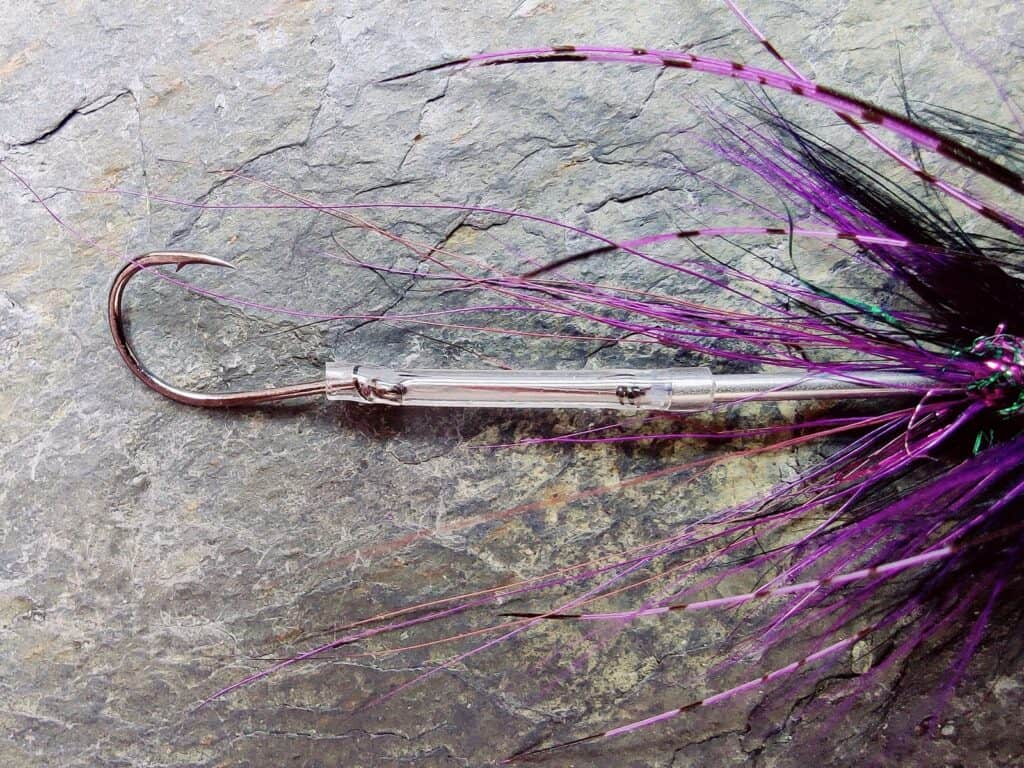Tying Intruder Flies on Needle Tubes
For the tying of Intruder flies, or indeed any kind of salmon, steelhead and sea trout flies, it might be argued that Waddington shanks have had their day. With the introduction of ultra-slim stainless steel Needle Tubes, Waddington shanks might be thought pretty much obsolete. Any fly that can be dressed on a Waddington shank (or on other similar wire shanks), e.g. Intruders, can be dressed more simply and more practically on a slim Needle Tube. I hope to show here the many advantages of the Needle Tube Intruder Fly, along with the inherent problems associated with salmon and steelhead flies dressed on Waddington shanks.
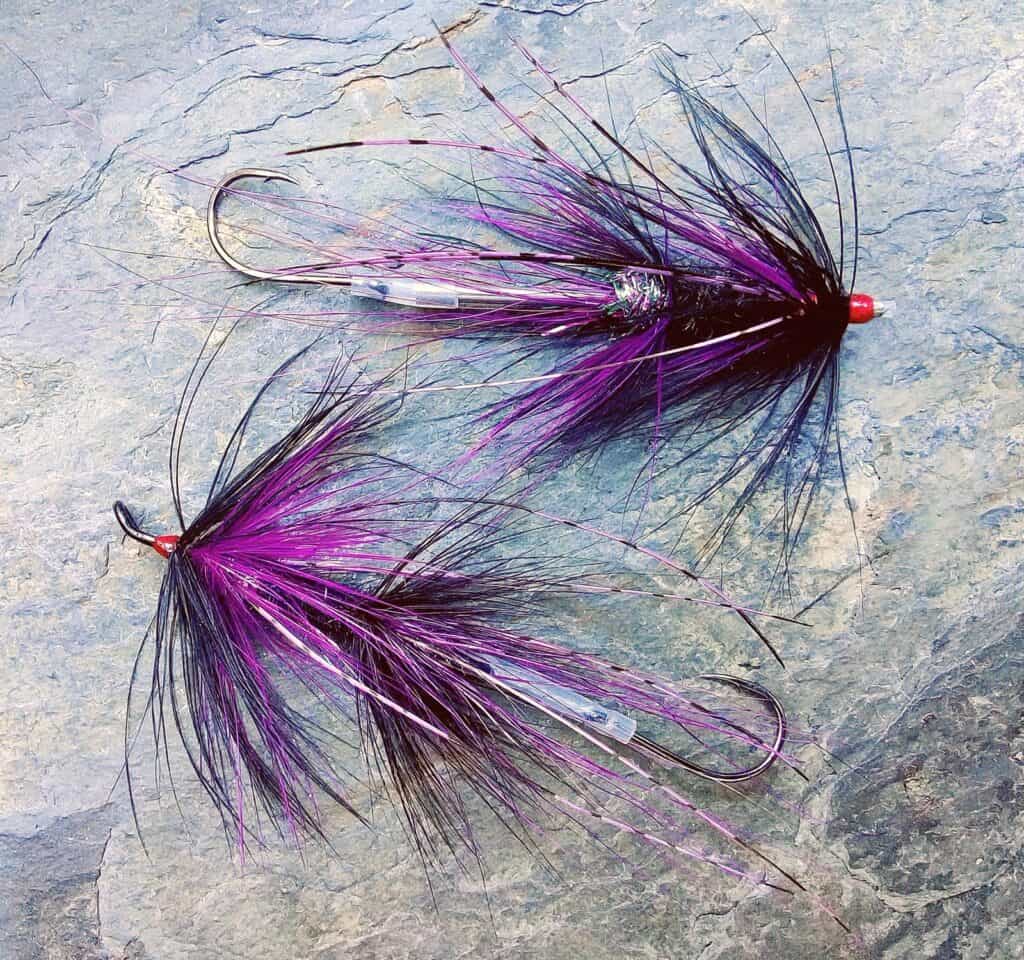
The History of the Waddington
The Waddington lure was devised by Richard Waddington in the middle of last century. In “Salmon Fishing”, published in 1947, he writes, “My ideal salmon fly, however, is quite revolutionary. The shank will remain a steel bar – though were it not for the weight I should prefer something pliable like a heavy nylon strand. This will be linked with a plain loop to a small triangle. The fly will not be dressed in the normal way. The body will be the same but the wing will disappear to be replaced by plenty of hackle dressed all round the fly so that whichever way it is turned it will have the same appearance.
I surmise that this fly will look more natural in the water; that the small triangle is less obvious than a large hook and that once the fish is hooked it will give a better hold. The link in the shank will obviate much of the strain and movement in the hook.”
Over the following decades the “Waddington” became popular with those salmon and sea trout fly anglers seeking to create a medium weight salmon or sea trout fly in the longer lengths but with a slimmer profile than flies dressed on conventional tubes (copper, brass, aluminium or plastic), which then had a typical diameter of 2.5mm to 3mm.
For more than half a century, and still to this day, the Waddington lure remains a favourite among many salmon and sea trout anglers, for the reasons given above. In addition to Richard Waddington himself, I recall that Bill Currie liked a Dark Mackerel dressed on a short Waddington shank for sea trout at night, as did Moc Morgan and Graeme Harris for late nights on their Welsh sea trout rivers. The Waddington offered what the alternatives of the time (bulky tubes in lightweight plastic and aluminium, or heavyweight copper and brass tubes) could not, i.e. a long slim lure of medium weight which would sink readily to a good fishing depth without snagging on the riverbed, and would be reasonably easy to cast on either single or double handed rods.
It served its purpose well. However, while the Waddington lure (dressed on a Waddington shank) does have a slim profile, suitable weight, and allows the use of a relatively small treble hook, considered more efficient than a large long shank single hook, it has two important disadvantages. Firstly, the Waddington is not so easily dressed as a tube fly and, secondly, the treble (or single or double) hook is not so easily fitted or readily replaced when damaged.
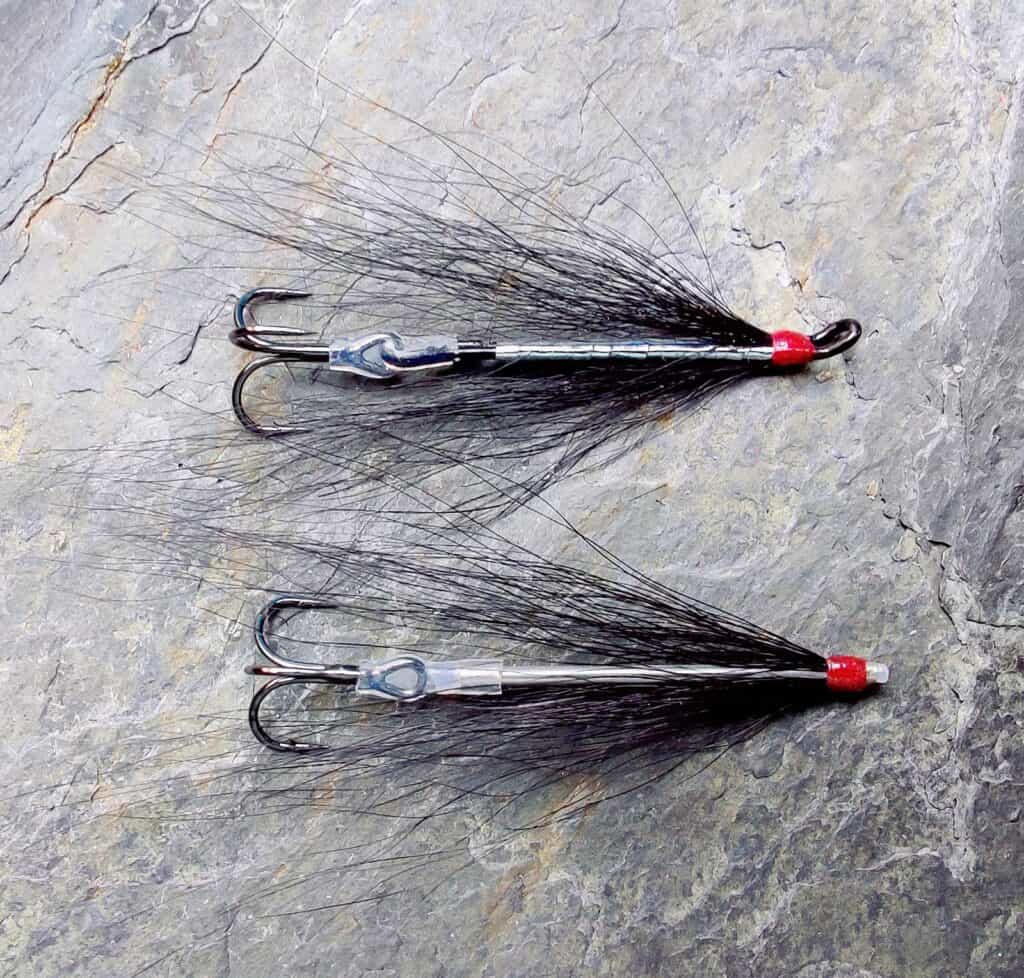
Disadvantages of the Waddington Shank
I have found the dressing of Waddington shanks for my salmon and sea trout flies quite fiddly and I was never happy with my efforts. The rear end of the dressing and the attachment of the hook always presented difficulties which I never managed to solve to my satisfaction. The Waddington shank may be dressed and the hook at the rear may be attached in one of the following ways, none of which seemed to me to be satisfactory:
- The hook is fitted into the rear end of the Waddington shank and the body dressing is applied just short of the split in the shank. The hook is allowed to hang freely, allowing for the relatively easy replacement of a damaged hook.
- The hook is fitted and the dressing is applied over the full length of the shank (covering the split in the shank) and the hook allowed to hang freely. To allow a hook change, the dressing must be removed from the rear of the shank.
- The hook is fitted and a strand or two of stiff nylon used to join the hook to the shank to hold the hook in line with the shank. The dressing is then applied, partially or completely, over the shank. To replace the hook, the nylon stiffener must be cut off, the hook replaced, the nylon stiffener retied. This is not really practical if the full length of the Waddington shank has been dressed over the nylon stiffener.
- The hook is fitted, with a length of silicone, PVC or heat-shrink tubing added over the hook shank, and the dressing applied to the Waddington shank, again stopping short of the gap in the shank, to allow for hook replacement. The tubing is then slid partially up the rear of the Waddington shank when the dressing is completed to hold the hook in line. To replace the hook, the tubing is slid down the hook shank (or heat shrink tubing cut off) before replacing the hook and tubing.
- The hook is fitted, with a length of silicone, PVC or heat-shrink tubing added over the hook shank, and the dressing applied over the full length of the Waddington shank. The tubing is then slid partially up the rear of the Waddington shank when the dressing is completed to hold the hook in line. To replace the hook, the dressing must be removed/reapplied from the rear of the shank, before replacing the hook and tubing. Again, not really practical.
- The Waddington shank is dressed over the full length with no hook fitted. The leader is threaded through the Waddington shank eye and down through the rear eye, then through a length of silicone or PVC tubing before tying on the hook, which is then held in place by the silicone or PVC tubing, as in a tube fly. If using this method, there is a risk while casting of the hook being pulled too far into the tubing, causing the hook to fish out of line with the Waddington shank.
- The hook is fitted to the rear of the Waddington shank via a small split-ring. The dressing is then applied to the full length of the Waddington shank, covering the split in the shank. The hook is allowed to hang freely on the split-ring and may be fairly easily replaced when damaged, without having to redress the Waddington shank. A split-ring might also be used in this way to replace a damaged hook which has been attached by any of the above methods. The damaged hook on any Waddington could be cut off with pliers before attaching a split-ring and new hook, with the hook hanging freely on the split-ring.
- In recent years, the Waddington shank has been used to form the basis of an Intruder style of fly for Pacific salmon and steelhead (or Secret Weapon type of hook attachment for sea trout), whereby a rear loop of wire, braid or nylon is first attached to the Waddington shank, and a single hook attached to the loop, before the Intruder fly is dressed. The hook can then be replaced if damaged when fishing. This technique as used in the making of Intruder flies is an elegant and workable solution but such an arrangement has inherent disadvantages, as listed below.
Waddington Shanks for Intruder Flies
As indicated in the final point above, from early on in its development by Ed Ward, Jerry French and other accomplished salmon and steelhead anglers on the Pacific North West rivers of the United States and Canada, the Waddington shank, or other similar wire shanks, either double or single shank, became the preferred platform for the tying of Intruder Flies.
The “Intruder” was developed in the early nineteen nineties by those pioneering fly anglers initially for Chinook or King salmon. It quickly found favour, too, with rainbow trout and steelhead anglers. As the name suggests, the Intruder is a large offering designed to intrude on the territorial space of the salmon and provoke an aggressive response. The first Intruders were dressed on large streamer hooks, but the originators, seeking a more functional and more fish-friendly solution, found that they could make an even larger and lighter fly but attach a much smaller hook at the rear. Their solution was to dress the fly on a wire shank, perhaps a large hook with the bend cut off, and attach a smallish hook to the rear end by means of a loop of nylon or wire secured to the shank with thread and glue. Wire shanks of this type, and subsequently Waddington shanks, with a trailing hook linked behind as described, allowed a large, yet reasonably easily cast lure to be created and fished at a reasonable depth for deep lying fish. Today, such Intruder flies of varying weights may be fished at any required depth often with the aid of modern Skagit lines and MOW tips.
Disadvantages of Waddington Shanks for Intruders
While the Intruder dressed on a wire shank with a trailing hook fitted to a loop of nylon, braid or wire is undeniably an effective, attractive and elegant solution, it has several inherent disadvantages.
The fixing of the flexible loop and the dressing of the shank can be a fiddly business, while the stability, orientation and durability of the hook connection when fishing cannot always be relied upon. Fitted to a loop of strong nylon, the hook may not always lie straight, directly in line with the fly; a loop of soft braid may hang down below the horizontal and may have to be somehow stiffened, for example by reinforcing it with a silicone or PVC tube linked to the rear end of the wire shank (see Salmon Intruders); a soft flexible braided loop may also be prone to catching up on the leader while casting; while a wire loop may be prone to kinking. In addition to these problems, the dressing on the wire shank, over which so much care, time and attention has been taken, may be easily damaged by a fish’s sharp teeth, a potential problem with all flies dressed on wire shanks, regardless of method of hook attachment. Flies dressed directly on hooks, of course, suffer from the same disadvantage. In contrast, when a fish is hooked on an Intruder fly dressed on a tube, the tube may on occasion slide up the leader out of the way during play and the dressing is less likely to be damaged, particularly if using a free-swinging hook. If the Intruder fly is dressed on a slim stainless steel Needle Tube, as in the examples below, the rear half of the polished silver tube body may be left undressed, much simplifying the whole tying procedure, reducing the possibility of damage to the fly body, and the finished Needle Tube Intruder will be as slim as the shank version and of similar weight, while the silicone hook link is equally flexible.
Comparison of Waddington Shank and Needle Tube for Intruder Flies
The photographs below show a standard Waddington shank and Needle Tube before dressing as an Intruder style of fly. The Waddington shank is 35mm long and the Needle Tube 40mm long, diameter 1.5mm. The weight of the Waddington shank with a braided loop and hook is 0.57g. The Needle Tube (1.5mm diameter) with silicone sleeve and hook weighs 0.43g. A 1.8mm diameter Needle Tube 35mm long with sleeve and hook would weigh 0.61g. A typical dressing, such as that shown below, would add a further 0.15g to each. So:
- a 40mm 1.5mm diameter needle tube with dressing, silicone sleeve and hook would weight about 0.58g
- a 35mm 1.8mm diameter needle tube with dressing, silicone sleeve and hook would weight about 0.76g
- a 35mm Waddington Shank with loop, hook and dressing would weigh about 0.72g
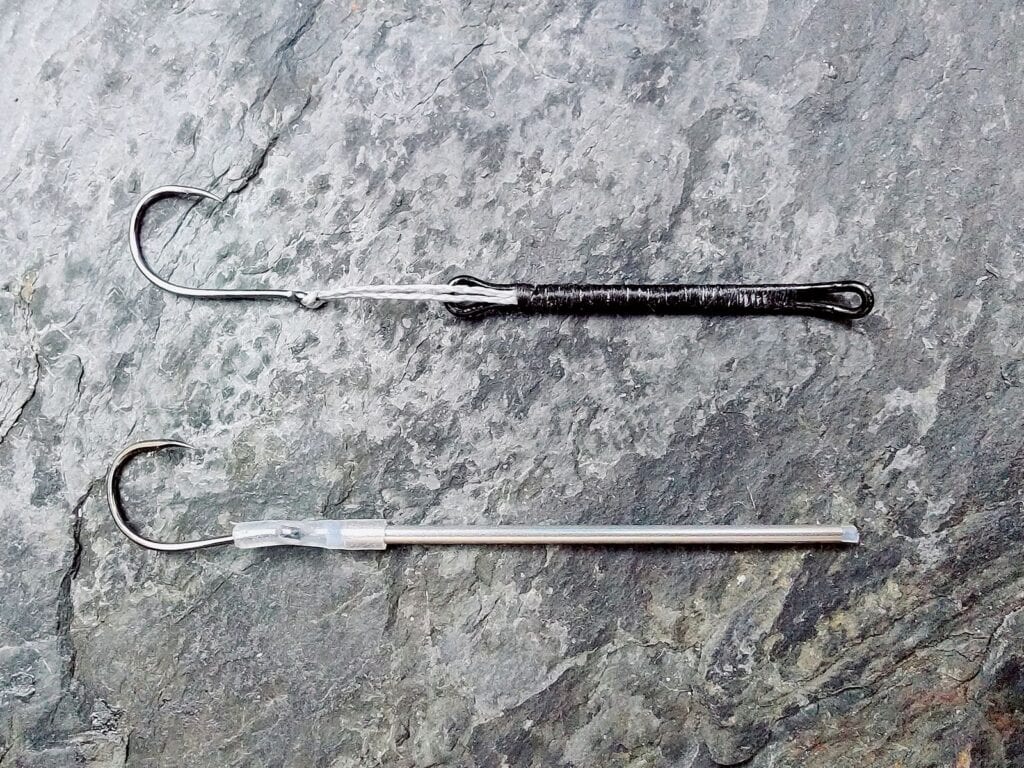
A braided loop of the type shown attached to the Waddington shank above would droop below the horizontal when fishing.
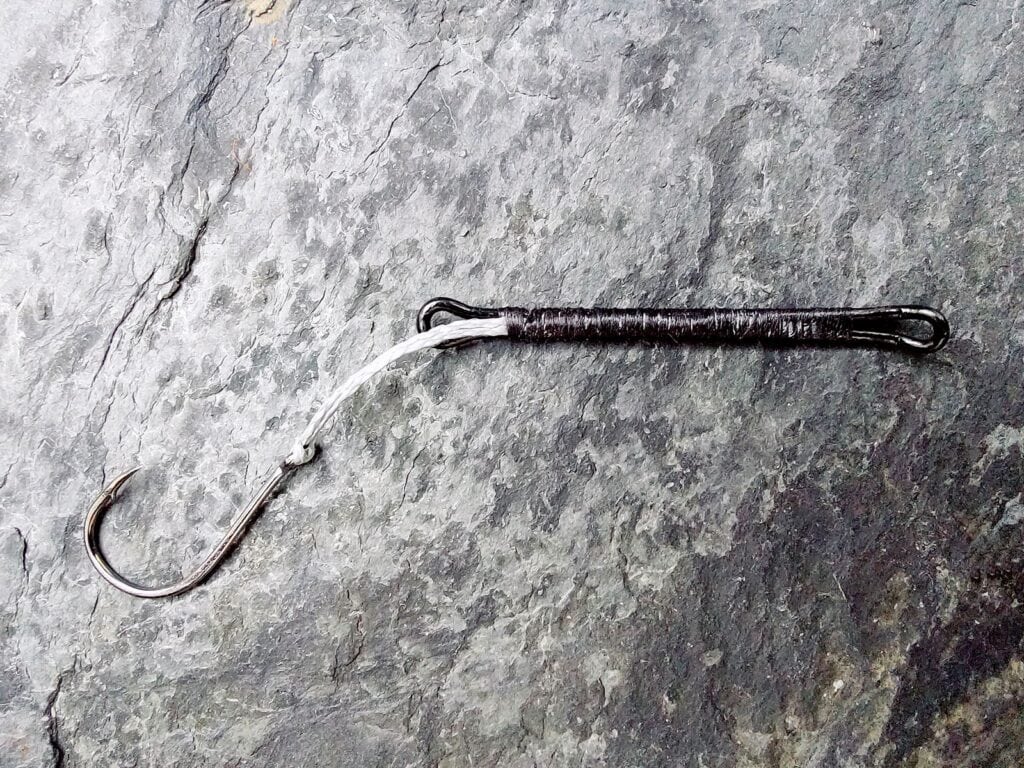
If the angler wanted the hook to swim directly behind and in line with the shank, the braid might be stiffened by a length of silicone tubing (as shown below), stiff enough to keep the loop straight but soft enough to allow the connection to flex when a fish is hooked. Such tubing might also serve to protect the braided loop from damage while fishing. The photograph below illustrates the kind of loop connection devised by Jerry French to overcome the drooping loop. I believe he calls his set-up the Ultra Rig, as described in this video Jerry French Ultra Rig . He has also put together an Ultra Rig Kit for fly tyers. His solution, the result of many years spent perfecting it, employs a round eye or return eye single shank, more refined than my illustration! It also allows the dressing of larger Intruder flies, the kind more commonly fished in the Pacific North West. His kits, for example, include single shanks up to 51mm long. Alternative solutions to the drooping loop might be to use wire or stiff monofilament to form the loop, but, as described above, these have their own drawbacks.
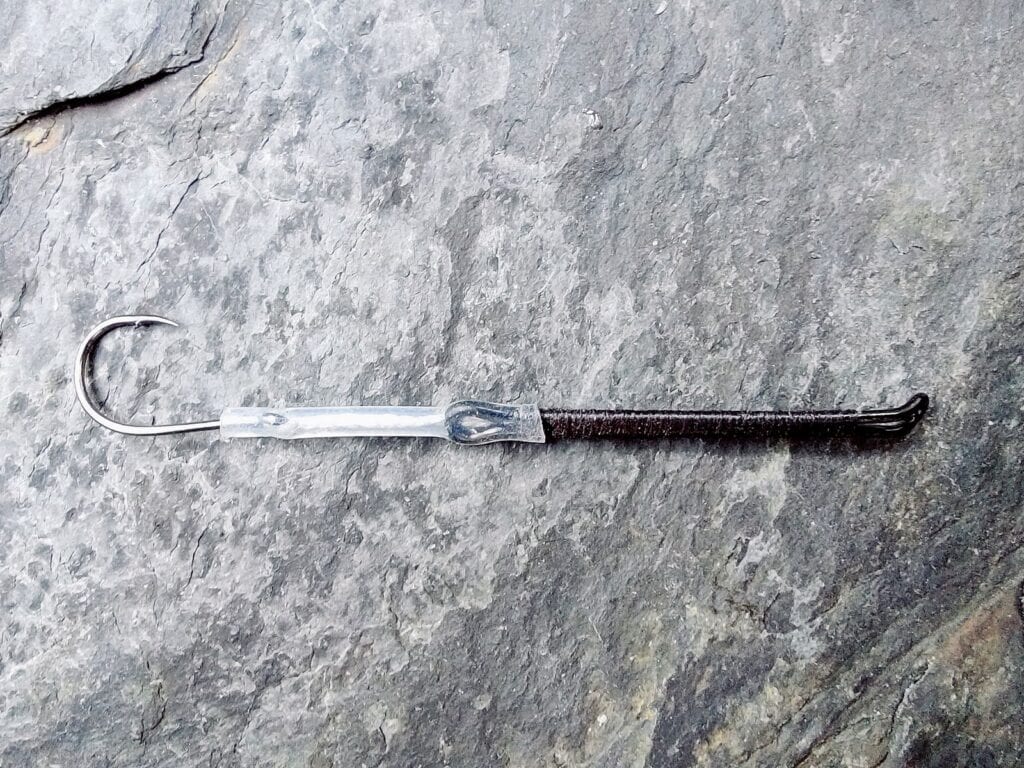
In order to change the hook, the silicone sleeve can be slid up onto the hook shank to free the loop to remove and replace the hook, as shown below. Again this process is explained by Jerry French in the links above, along with his thinking behind it.
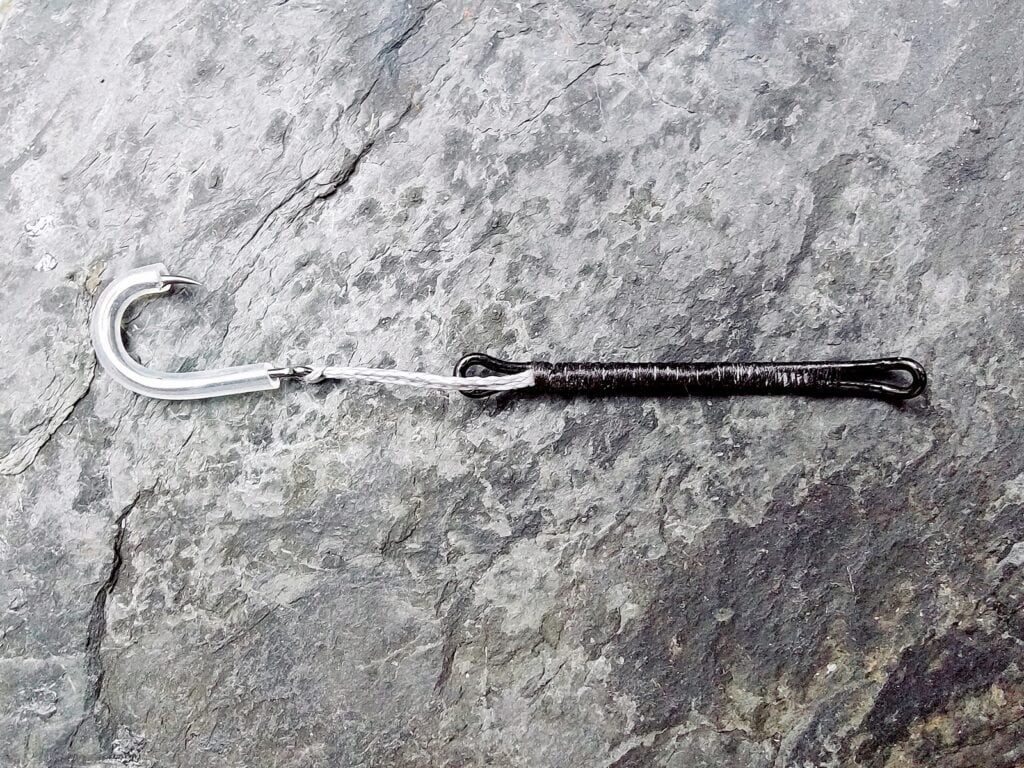
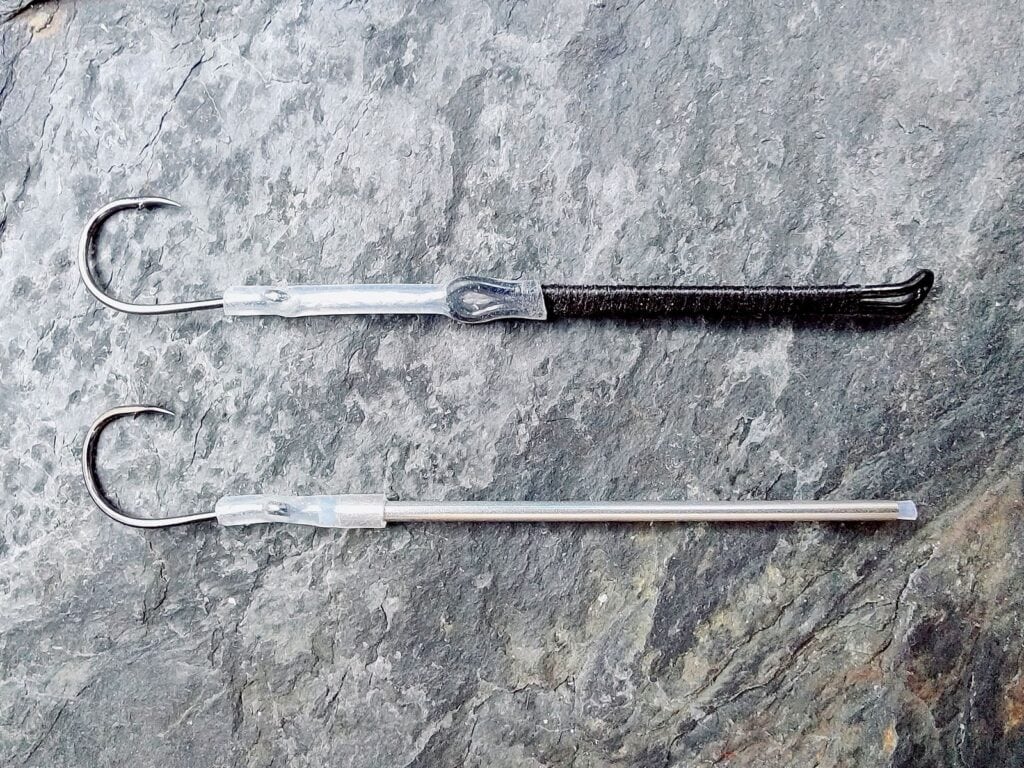
Despite the time and care required in the making of a shank-based intruder with trailing hook, and in the absence of a credible alternative, much effort has gone into overcoming the inherent problems of the design, with some success as noted in the case of Jerry French’s solution. However, the construction of an Intruder on a wire shank, with a trailing hook, is relatively complex and time consuming, however effective the resulting fly may be. And the changing or replacement of the hook remains an irritant, compared to the ease of changing a tube fly hook. Consequently, for the reasons outlined above, Intruders are now often dressed on tubes rather than wire shanks. After all, anything that can be tied on a wire shank can be tied on a tube.
Tubes of various lengths, diameters and densities do generally offer major advantages over flies dressed on wire shanks in that they are, in my experience at any rate, much easier to dress and, secondly, the hook is more easily fitted or changed when damaged or to suit changing circumstances. But the weight and diameter of commercially available tubes were not ideal for the tying of Intruders. Neither the bulky, lightweight plastic and aluminium tubes nor the heavyweight copper and brass tubes commonly available were capable of replicating the mobile, slim-bodied, medium weight lure achievable by dressing on a wire shank. Today, the ultra-slim stainless steel Needle Tube, with a diameter of only 1.5mm, presents a credible, even superior, alternative, perfect for the tying of small to medium length Intruder flies, offering several advantages over the Waddington and other wire shanks, with no disadvantages – although the needle tubes do require a dedicated tube vice or tube adaptor to hold them securely for tying. They should not be mounted on a pin or mandrel, as this could potentially damage the plastic tube liner. The Grays Tube Fly Adaptor is ideal for this purpose.
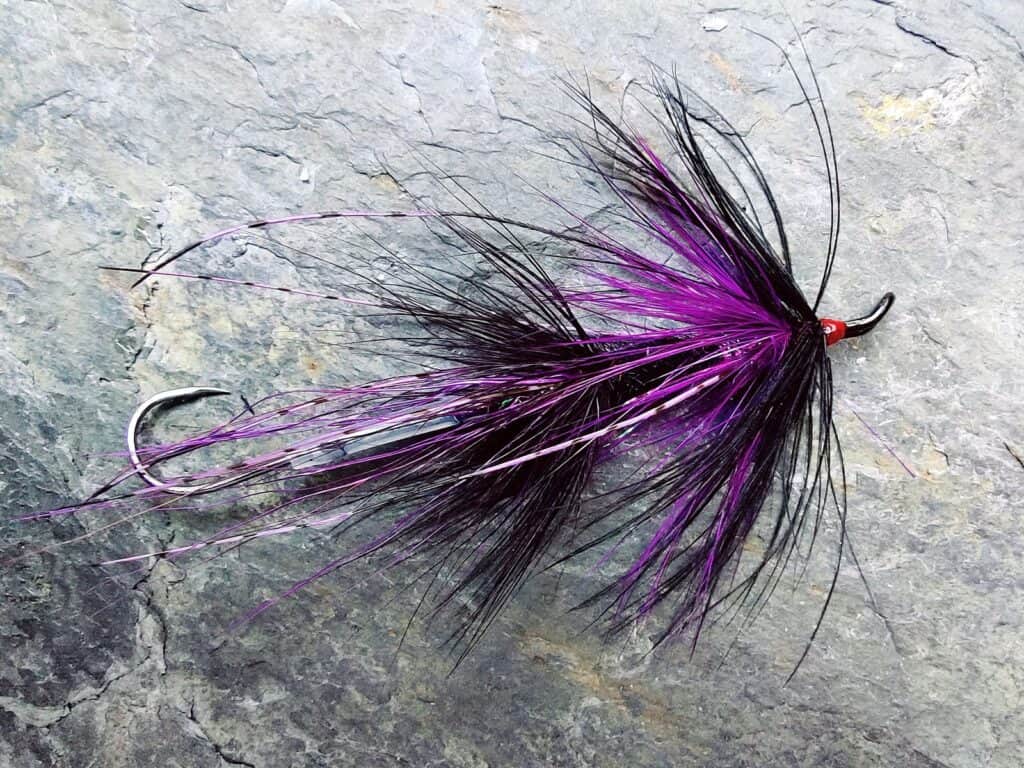
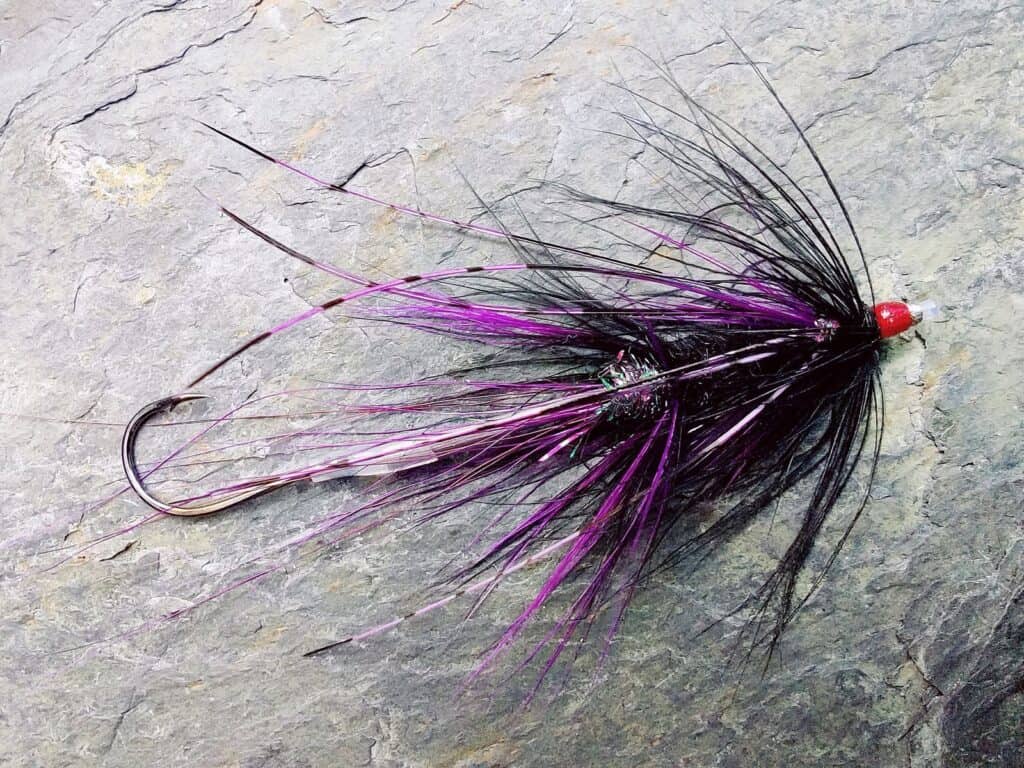
Needle Tubes for Intruders
Seeking an alternative to the Waddingtons and tubes available in the 1990s, for my late night sea trout fishing on the River Earn in Perthshire, I first devised the Needle Fly, the slimmest of all flies, before developing the Needle Tube, which has since recorded many notable successes for a wide range of species worldwide, including Atlantic and Pacific salmon, North American steelhead, and sea trout throughout Europe. See Needle Tube Fly Fishing
Needle Tubes, ultra slim stainless steel tubes developed by Grays of Kilsyth in Scotland and introduced in 2008, are I think pretty much ideal for tying Intruders. They are as slim as, and about the same weight as a Waddington shank, and are available in two diameters/weights in lengths ranging from 10mm to 40mm. They are easier and quicker to dress, with a more practical hook attachment than any shank-based lure.
Weight Comparison of Waddington Shank V Needle Tubes
Needle Tubes are available in two diameters: 1.5 mm diameter and 1.8mm diameter. A standard 35mm undressed Partridge Waddington shank was weighed and compared to the weights of the same length of each diameter Needle Tube, giving the following results:
35mm Waddington shank: 0.42g (weight with hook and dressing: 0.72g)
35mm Needle Tube 1.8mm diameter: 0.46g (weight with hook and dressing: 0.76g)
35mm Needle Tube 1.5mm diameter: 0.26g (weight with hook and dressing: 0.56g)
Therefore an intruder tube fly dressed on a needle tube of 1.5mm diameter would be marginally lighter than an Intruder fly dressed on a standard Waddington shank of the same length; an intruder tube fly dressed on a needle tube of 1.8mm diameter would be marginally heavier than an Intruder fly dressed on a Waddington shank of the same length. All have closely similar densities and, given similar dressings, will sink at a similar rate to a similar depth. A further benefit of the needle tubes is that they require no body dressing over the slim shiny stainless steel body, although many tyers will prefer to add a full or partial body dressing or some additional mobile or flashy fibres to the tube dressing to enhance the action or attraction of the fly.
Tube Fly Hook Connection
The tube fly hook is very easily attached or changed by simply tying it to the end of the leader and inserting the hook eye into a short peice of PVC or silicone tubing slipped on to the rear end of the tube, as shown below. Alternatively, the hook might be allowed to swing freely at the end of the tube (see Tube Fly Hooks )
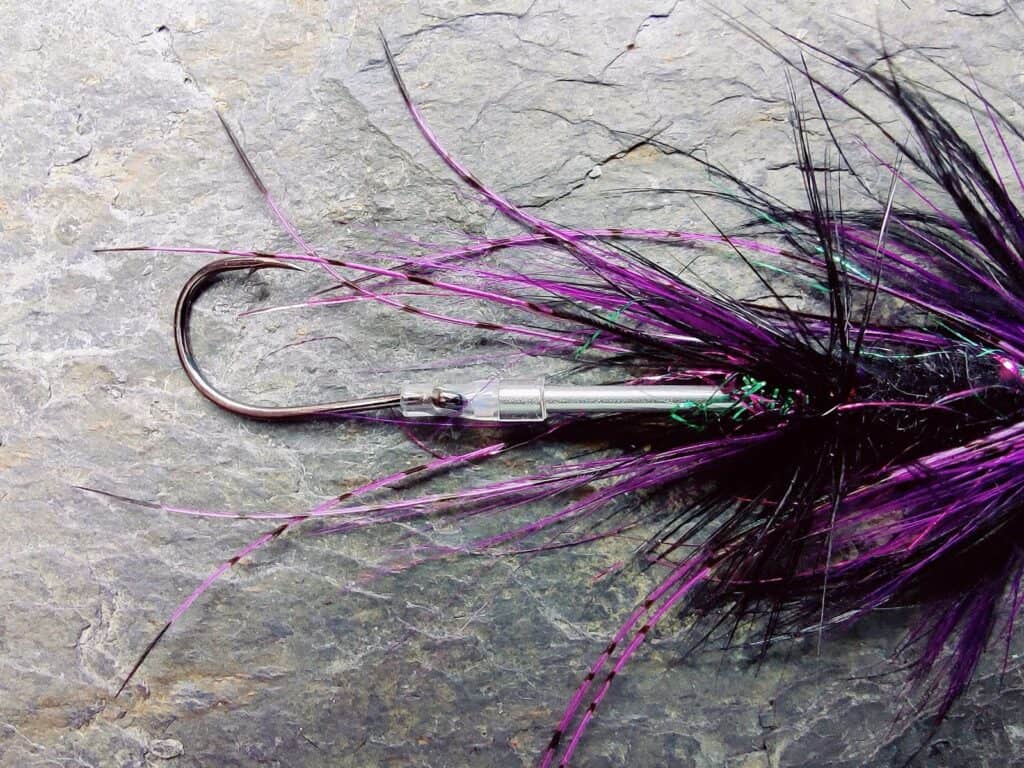
Intruder Tube Fly Hook Extension
If the hook is preferred to fish further to the rear of the Intruder Tube Fly, it may be connected in the following ways, as might be done on a conventional tube fly. In the first example shown below, instead of simply inserting the hook (as in the Intruder tube fly above) into the silicone or pvc extension tubing, the hook might be connected via a loop in the leader. The knot is then pulled into the pvc tubing (here I have used tubing with an internal diameter of 1mm). The knot butts up against the rear of the Needle Tube, allowing the hook to swim a little further behind the Intruder dressing, similar to the type of hook connection on a shank based Intruder.
Intruder Hook Extention Method One
Intruder Hook Extention Method Two
If the angler prefers his hook to be more firmly fixed in position behing the Intruder Tube, a slightly longer pvc or silicone extention tube might be used, as shown below, which allows the eye of the hook to be secured in the end of the extension tube, with less movement of the hook when fishing. Note here that it might be thought simpler to simply tie on a hook and insert the hook eye into the rear of the extended length of PVC tubing. The problem with this is that, when fishing, the pull of the line on the hook will cause the tubing to bend and the hook will not lie straight behind the fly. Hence the use of a loop, which avoids this problem.
All of this might, of course, be thought unnecessary, when a perhaps simpler solution is to adjust the length of the fly dressing on the tube (when tying the fly) to achieve the same result! However, connecting the hook via a looped extension does allow the use of a shorter, and lighter, needle tube for the same length of fly. Also, the use of an extended hook link such as that shown above may allow a longer Intruder dressing to be applied to even the longest length of needle tube (40mm), thus creating a bigger/longer overall fly length.
Examples of Needle Tube Intruder Flies
Shown below are a few Intruder style flies modestly dressed on slim stainless steel Needle Tubes, diameter 1.5mm. Their total length, from head to hook bend, is between one and a half and two inches. These are, by North American standards, fairly small Intruders (perhaps a contradiction in terms), dressed more for Atlantic salmon than for Pacific salmon or steelhead, although fairly small needle tube flies have recently proven very effective for the Chinook, and other Pacific salmon species, on Vancouver Island and for the steelhead of Lake Erie and its tributary streams. Pacific salmon and steelhead anglers might easily adapt their own favourite Intruder dressings to their tying on Needle Tubes, which are available in lengths up to 40mm, allowing the dressing of Intruder style flies of up to around 3 inches in length.
Simply tied with an easily changed hook
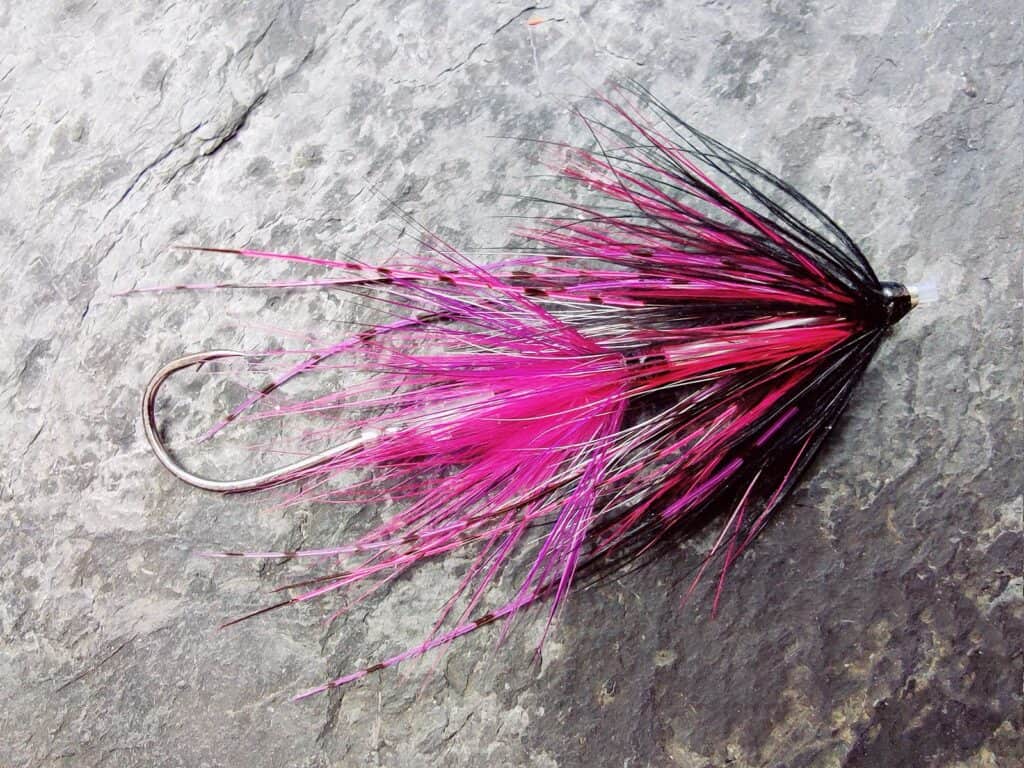
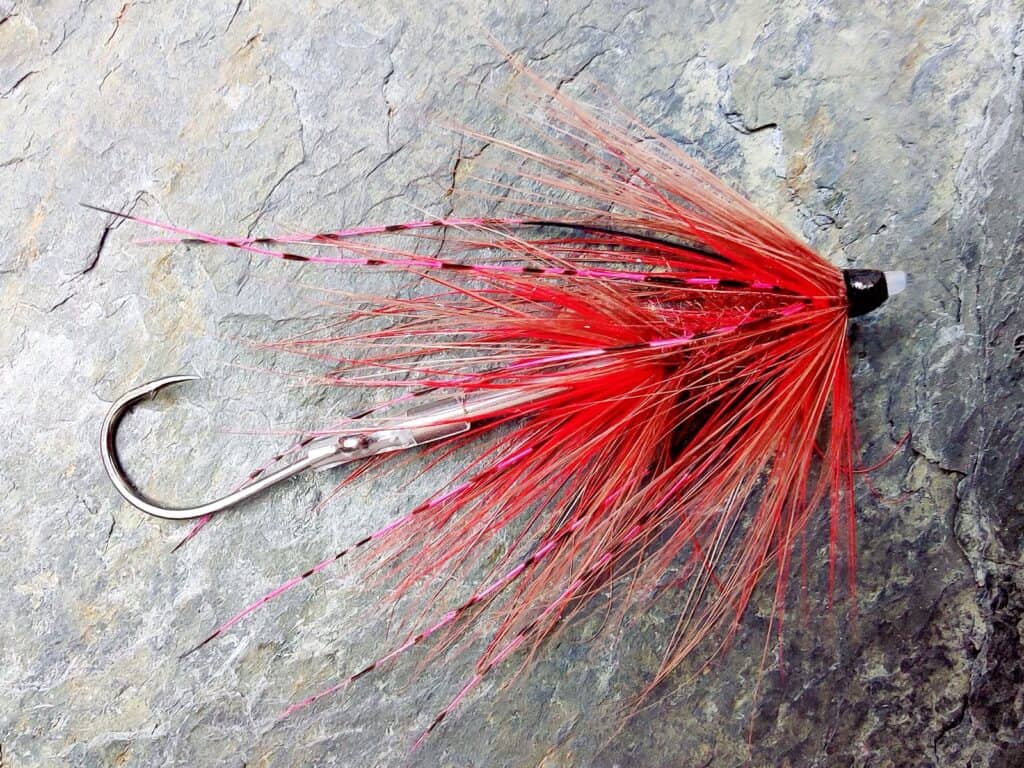
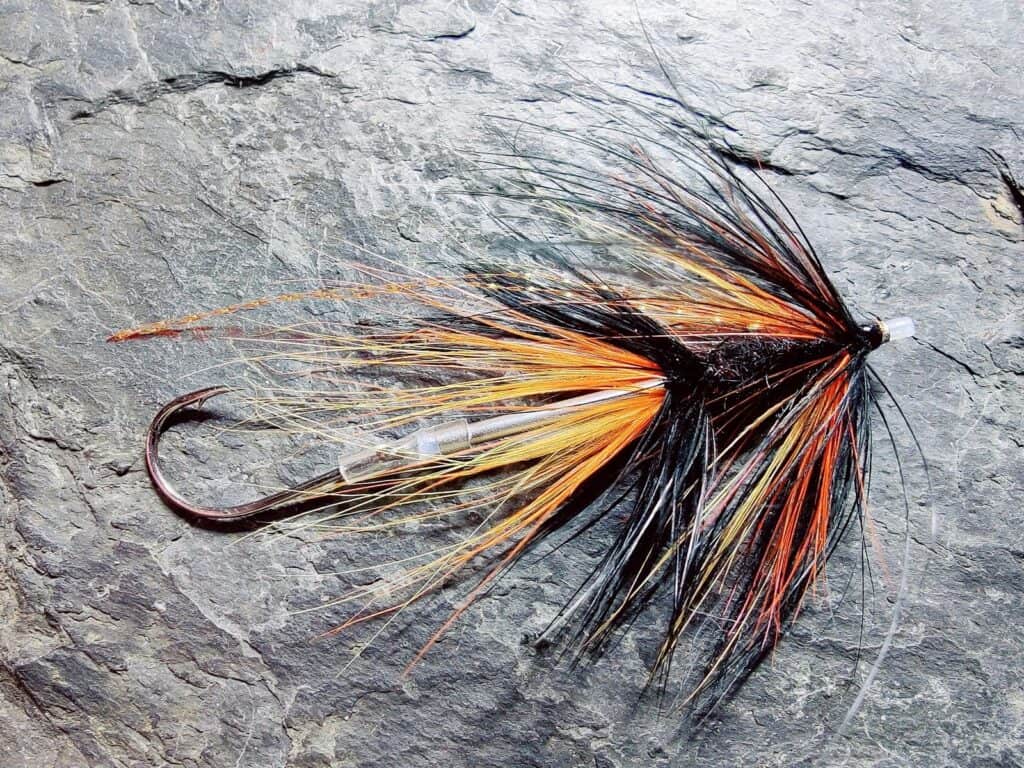
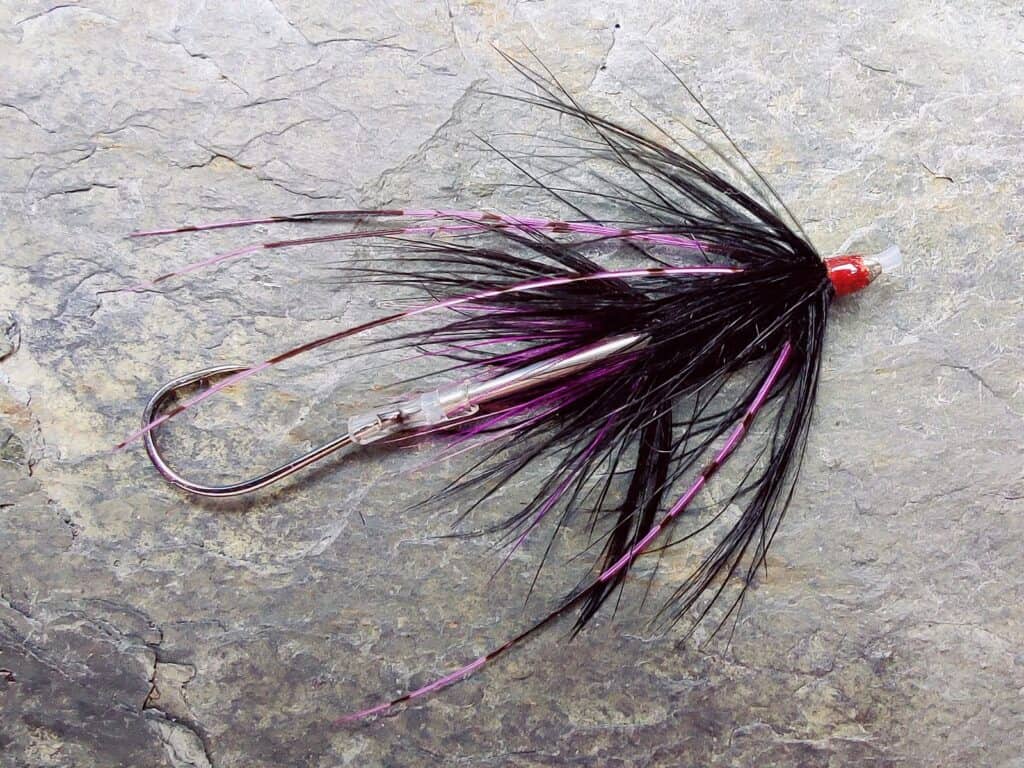
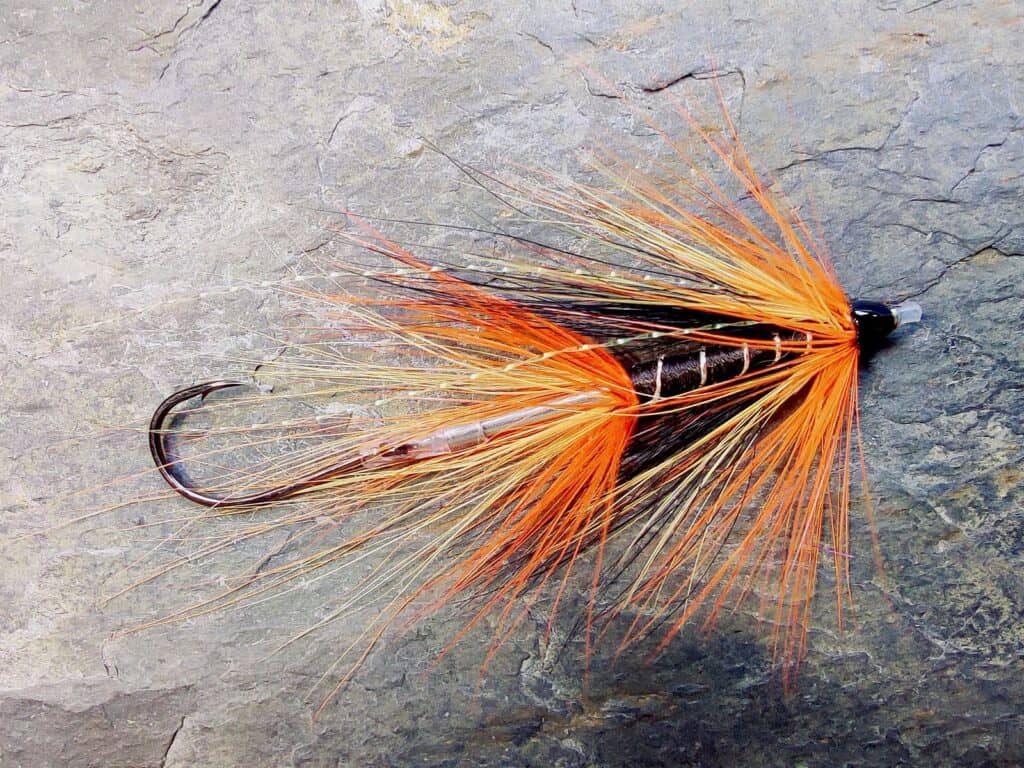
Orientation of Single Hooks on Tube Flies and Intruders
Note that the single hooks on the above Intruder Tube Flies have been fitted with hook points uppermost. An undressed single or double hook will, as a rule, tend to swim naturally, and will be most stable, with hook points up. The attachment of single (and double hooks) will, therefore, be influential in determining the way the fly swims. So, when attaching a single or double hook to the rear of a tube fly, it would be advisable to connect it with the hook points uppermost, i.e. in line with, rather than opposed to, the natural orientation/equilibrium of the hook. This will aid the stability of the tube fly, reducing any tendency for the fly to swim upside down or on its side. Other benefits of setting the double or single hook with the points uppermost are a) a hair wing cannot become caught up on the underside of the fly b) the hook point is less likely to snag or be damaged on riverbed rocks and c) in the Autumn, the hair wing (on flies with a defined upper wing) acts to an extent as a weed guard, reducing the likelihood of leaves being hooked while fishing.
A Simple Alternative Intruder Dressing
A simple alternative to tying a rear station on the intruder tube fly might be to add instead a very sparse simple dressing to the tube hook, creating a Tingler Tube Fly. A “Tingler” is a tube, more specifically a slim stainless steel Needle Tube, armed with a lightly dressed single hook, as shown below.
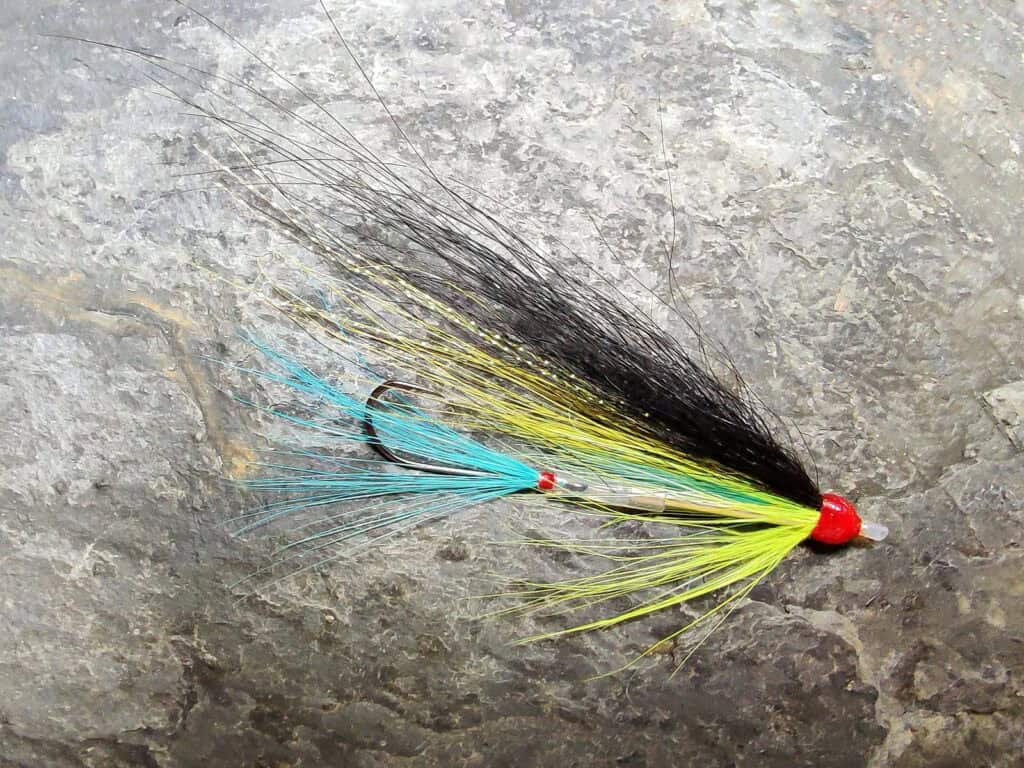
A benefit of this option is that hooks with different dressings may be combined/interchanged with tubes of varied dressings to create a whole range of Tinglers. Change the colour of the tail, you have in effect a different fly. Such a change can have a dramatic effect on the appearance of the lure. The size, weight and dressing of both tubes and hooks may be varied according to taste, species, conditions and seasons.
